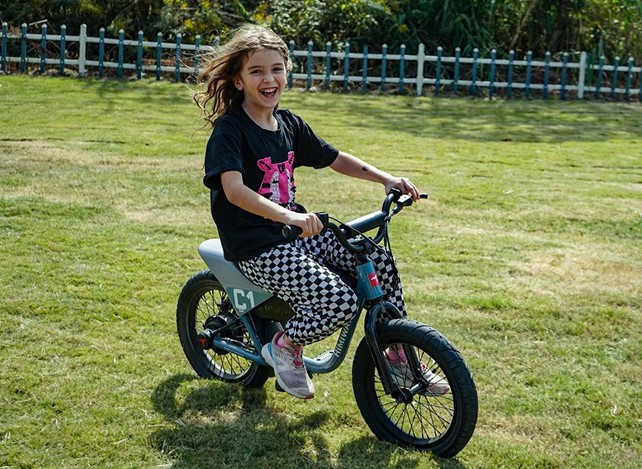As the holiday season begins to sparkle, every parent wants to capture their kids’ Christmas spirit. There’s just something magical about these precious moments that can’t be repeated in the same way throughout the year. These snapshots go beyond mere images; they are portals to the past; moments in time that is as fleeting as it is cherished.
Most often these memories are capture without planning. Just have your camera handy and click. However, there is also something to be said for putting in the extra effort to go beyond a random snapshot. With the right tools and ideas in hand, it’s not much effort at all.
Importance of Capturing Memorable Christmas Pictures of Kids
The Christmas season is a magical time for kids, and their pure joy and wonder are unmatched. Taking Christmas pictures of your kids during the holiday season lets you freeze those incredible emotions in time. They provide beautiful memories you can look back on and even share with them when they’re older. Highlights can include:
- The first glimpse of the Christmas tree lights.
- Writing a wish list for Santa Claus.
- Baking and decorating gingerbread cookies.
- The excitement of Christmas morning.
Benefits of Using Fun and Creative Backdrops for Kids’ Christmas Pictures
Creating festive backdrops for your kids’ Christmas pictures is not just a fun activity, it adds a unique touch to your photos, setting them apart from Christmas stock photography. They:
- Enhance the festive spirit.
- Encourage kids to engage with the photography process.
- Add depth and vibrancy to the photos.
- Make your photographs a unique work of art.
So, let’s dive into a world of fun and creative holiday backdrop ideas that’ll make your kids’ Christmas pictures this year unforgettable!
Traditional Christmas Backdrops
Nothing piques the holiday spirit quite like traditional Christmas backdrops. They’re timeless, infused with the colors and elements typical of the season, and can bring your child’s Christmas pictures to life!
Red and Green Christmas Tree Backdrop
Let’s begin with the classic red and green Christmas tree backdrop. Create a cozy atmosphere with a tree decorated with red and green ornaments, tinsel, lights, and a dash of artificial snow for a snowy effect. Place a comfy chair or a makeshift sleigh with a blanket in front, and voila! You have a picturesque backdrop ready for your little ones. Don’t forget to include:
- Strings of popcorn and cranberries for a rustic touch on your tree.
- Handmade ornaments for a personal touch.
- A glowing star or angel on the tree top for the perfect festive flare.
Winter Wonderland Backdrop with Snowflakes and Trees
Next is the enchanting Winter Wonderland backdrop. The key here is to create a mini winter scene with paper or cotton snowflakes, frosted trees, and maybe even a cute little snowman. Use blue, silver, and white colors predominantly and sprinkle in some twinkling lights for a magical effect. Kids will love pretending to be in their very own snowy wonderland! Key elements can include:
- Opaque curtains to mimic snowfall.
- Silver glitter for added sparkle.
- Snowy owls or reindeer for some wildlife fun.
Your traditional Christmas backdrops are ready to star in your kids’ delightful holiday photo shoot!

Image: Dreamstime.com
Festive and Whimsical Backdrops
To make your kids’ Christmas photos more lively and memorable, consider transforming your living room or backyard into a fabulous festive scene. Here are two creative themes that your kids will absolutely adore:
Santa’s Workshop Backdrop with Toys and Presents
What could be more magical than stepping into Santa’s own workshop? Create a festive backdrop that appears to be taken straight from the North Pole. With toys, presents wrapped in colorful paper, and holiday decorations all around, your kids will feel like they’ve been dropped right into Santa’s busy workshop. A giant chair for Santa’s seat, a giant light bulb decoration, and a festive Christmas tree in the background would make the setting even more enchanting.
Candyland Backdrop with Giant Lollipops and Gingerbread Houses
And if your kids have a sweet tooth, why not transform your setting into a Christmas Candyland? Giant lollipops, gumdrop trees, and gingerbread houses can be constructed using colored cardboard, or bought from a party supply store. Peppermint candy cushions and candy cane decorations will add a final touch to this festive and whimsical backdrop. Your kids will not only love the pictures but also have an abundance of fun in this sweet setting.
Nature-Inspired Backdrops
The great outdoors lends itself wonderfully to creating festive backdrops for kids’ holiday season photography. Let’s consider two delightful ideas that will give you creative, enchanting, and fun pictures.
Pine Forest Backdrop with Twinkling Lights
Imagine a pine forest with twinkling Christmas lights creating a magical environment for the kids to play around and discover. This idea channels the beauty of nature while adding a twist of holiday spirit. How to create it? Easy peasy, my friends – gather or purchase pine branches, set them up like a little forest, and maneuver twinkling lights among them. Dress your tiny ones in fluffy coats, and snap the joy of the enchanted forest exploration.
Snowy Mountain Backdrop with Sleigh and Reindeer
A snowy mountain backdrop becomes a winter wonderland for your kids. And what says Christmas more than a sleigh and reindeer? Here’s how to pull it off; use a large poster or painted wall for the mountain image, manufacture a sleigh out of cardboard or grab a toy one, and place plush reindeer toys around. Let the kids’ imagination run wild as they pretend to ride the sleigh around the North Pole. It won’t just make a great Christmas photo session, it will be an entertaining activity for the little ones too!
Magical Fantasy Backdrops
Imagination can run wild when it comes to planning your kids’ Christmas photoshoot, and what better theme to start with than magical fantasy backdrops? Creating a space that seems out of a storybook can make your little one’s shout with delight and result in dreamy, magical Christmas stock photography.
Enchanted Castle Backdrop with Fairy Lights and Snow
One magical theme to consider is an enchanted castle backdrop. You could use a painting or a printed backdrop of a castle dusted with snow. To create a captivating atmosphere, hang twinkling fairy lights. Encouraging your children to dress up as princes or princesses to match the scene can add an extra touch of magic. This backdrop is sure to spark their imagination:
- Use a castle painting or printed backdrop.
- Add twinkling fairy lights for a captivating atmosphere.
- Dress up time for more fun and to correlate with the backdrop theme.
North Pole Backdrop with Santa’s Sleigh and Elves
Another creative idea for a magical backdrop is immersing your kids in a North Pole scenery. Think about including key elements like Santa’s sleigh, his ho-ho-ing elves, and perhaps even a mystical pathway to Santa’s workshop. It’s a joyous and whimsical backdrop that reminded of the bustling energy of Christmas Eve.
- Decorate with key North Pole elements like Santa’s sleigh.
- Include playful figurines like Santa’s elves.
- A pathway leading to Santa’s workshop for a hint of adventure.
Your little ones will surely be enchanted and ready for some festive fun!
DIY Backdrops
Creating unique, do-it-yourself backdrops for your kids’ Christmas pictures can be a fun activity that the whole family can participate in. With a little imagination, some basic materials, and a sprinkle of Christmas magic, you can transform any spot in your home into a festive photo studio.
Christmas lights backdrops with colorful string lights
One of the simplest and most stunning backdrop ideas is to use colorful Christmas string lights. They add a warm, festive glow that truly captures the spirit of the holiday season. Here’s how to do it:
- Suspend a dark sheet or a large piece of cloth as a background.
- Hang an array of colorful string lights across the length of the cloth.
- Adjust the lights to create a crosshatch pattern, a waterfall effect, or any design that strikes your fancy.
The blur of twinkly lights behind your children will make your Christmas photos look magical.
Wrapping paper backdrops with festive patterns
This creative idea reduces waste and reuses your favorite Christmas wrapping papers. Start by choosing holiday-themed papers with bold patterns and colors. Then:
- Attach the wrapping paper to a wall or a large board.
- Arrange multiple sheets in a patchwork pattern to create a vibrant, festive backdrop.
- Alternatively, use one large sheet for a more uniform look.
Remember to match your kids’ outfits to the backdrop for a well-coordinated look. The wrapping paper backdrop will give your holiday photos a charming, homemade touch.
Interactive Backdrops
Nothing shouts “fun” louder than interactive backdrops for Christmas pictures. These act as perfect setups to bring out the playful side of your kids and create a festive atmosphere that’s reflected in each memorable shot.
Santa’s sleigh prop with a reindeer cutout for children to pose with
Make your little one’s dreams come true with Santa’s sleigh and a reindeer cutout for an interesting backdrop. Make sure to create a fun environment where your kids can pose as Santa’s little helpers. From pretending to drive the sleigh to adorably posing with the reindeer figure, there’s so much fun involved!
- It’s an amazing idea for group photos.
- Offers immense scope for storytelling in pictures.
Snow globe prop with a cutout for children to peek through
Let’s instill a little wonder in these festive photos with a snow globe prop. It will provide a cutout for kids to curiously peek through, adding to the magic of the holiday season.
- Kids will be fascinated by the unique setting.
- It’ll provide a perfect Christmas card rage maker!
Personalized Backdrops
Don’t you just love the idea of adding that personal touch to everything during the festive season? One of the cute and heartwarming ways of doing this is by creating personalized backdrops for your little ones.
Customized Backdrop with Child’s Name and Favorite Christmas Characters
Looking for something unique and memorable for your kids’ Christmas photos? A lovely idea can be a backdrop with their name and favorite Christmas characters. Picture this – a beautifully decorated backdrop filled with twinkling lights, festooned with ornaments, and your child’s name written artistically in the center. For an even more personalized touch, consider custom backdrops for Kids’ Christmas Photos, which can offer a wide variety of custom designs that perfectly match your child’s personality and holiday spirit. Add Santa Claus, Rudolph, or Frosty the Snowman sharing the frame, and you have a masterpiece. This creative setup not only makes your children feel special but also brings a magical and personal touch to your Christmas stock photography.
Photo Booth Backdrop with Props for Children to Dress Up and Have Fun
Speaking of fun, setting up a Christmas-themed photo booth can help crank up the joy even higher. Design a backdrop using festive colors and Christmas motifs, paired with a box full of fun props like Santa hats, reindeer antlers, and elf costumes. Encourage your kids to dress up and pose, watch the magic unfold as they bring to life the spirit of the holiday season in the photos. This unforgettable setup truly emphasizes the holiday cheers and makes for an engaging and enjoyable pastime for the little ones!
Outdoor Backdrops
Nothing encapsulates the magical spirit of Christmas quite like being outdoors surrounded by nature’s festive delight. There are two creative and fun outdoor backdrops that have always been kids’ favorites. These backdrops not only highlight the Christmas vibe but also provide a unique environment to snap those endearing photos.
Christmas Tree Farm Backdrop with Rows of Trees
A trip to a local Christmas tree farm can double as a perfect backdrop for your holiday photo session. Just imagine those rows of perfectly trimmed trees acting as a natural, cheery background. It’s like walking through a Christmas postcard! Having your children either play hide-and-seek around the trees or calmly picking their favorite one can result in some truly amazing and candid shots. This festive backdrop symbolizes the essence of the holiday season.
Ice Rink Backdrop with Children Ice Skating
Now, let’s think of a fun, active backdrop. Here’s where a local ice rink can work wonders. Capturing moments of your kids laughing and skating against a backdrop featuring sparkling ice is an unforgettable experience. It’s a dynamic, vibrant setting imbued with holiday vitality. Remember to shoot when the rink is decorated with Christmas lights and ornaments, it makes the scene even more enchanting! So, bundle up, set your camera to action mode, and let the candid moments roll at the ice rink!
Conclusion
Importance of having fun and creative backdrops for kids’ Christmas pictures
Capturing the magic of the holiday season in snapshots with your little ones is one of the most wonderful traditions of Christmas. Creative, festive backdrops can turn these pictures into unforgettable stories that spark joy every time you look at them. Not only do they add a festive punch to the shots, they also help the kids get in the holiday spirit, igniting their imagination, and creating a fun, exciting, and memorable photoshoot experience.
Summary of the different types of backdrops mentioned in the blog
In this blog, we’ve covered a colorful spectrum of backdrop ideas for cheerful Christmas photos:
- DIY paper winter scene backdrops – creative, cost-effective, and customizable.
- A traditional fireplace setting with stockings and real logs – classic and cozy.
- Indoor Christmas tree setups – perfect for that magical, intimate atmosphere.
- Outdoor snowy scenery – for capturing the breathtaking wonder of nature.
- Crafty chalkboard drawings – let your kid’s imagination soar!
Encouragement to try out these backdrops for memorable and festive pictures of children during the holiday season:
We hope our fun, creative ideas have inspired you to embrace the holiday spirit for your kids’ photoshoot. Remember, there’s no rule that says you have to stick to one backdrop – feel free to mix and match to capture a variety of magical Christmas moments. Each backdrop offers a unique framing for your precious holiday memories. So, grab your camera, your props, your kids and start capturing magical Christmas moments that you’ll cherish forever. Let the holiday photo fun begin!












